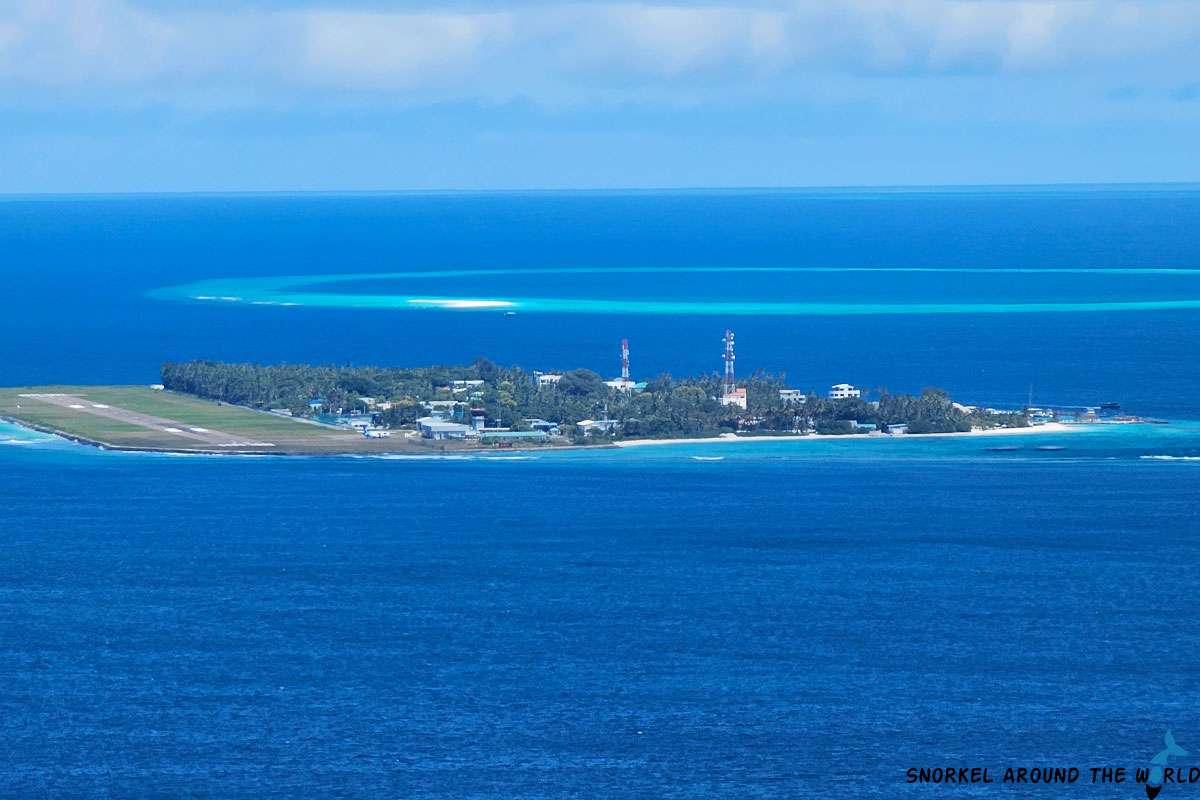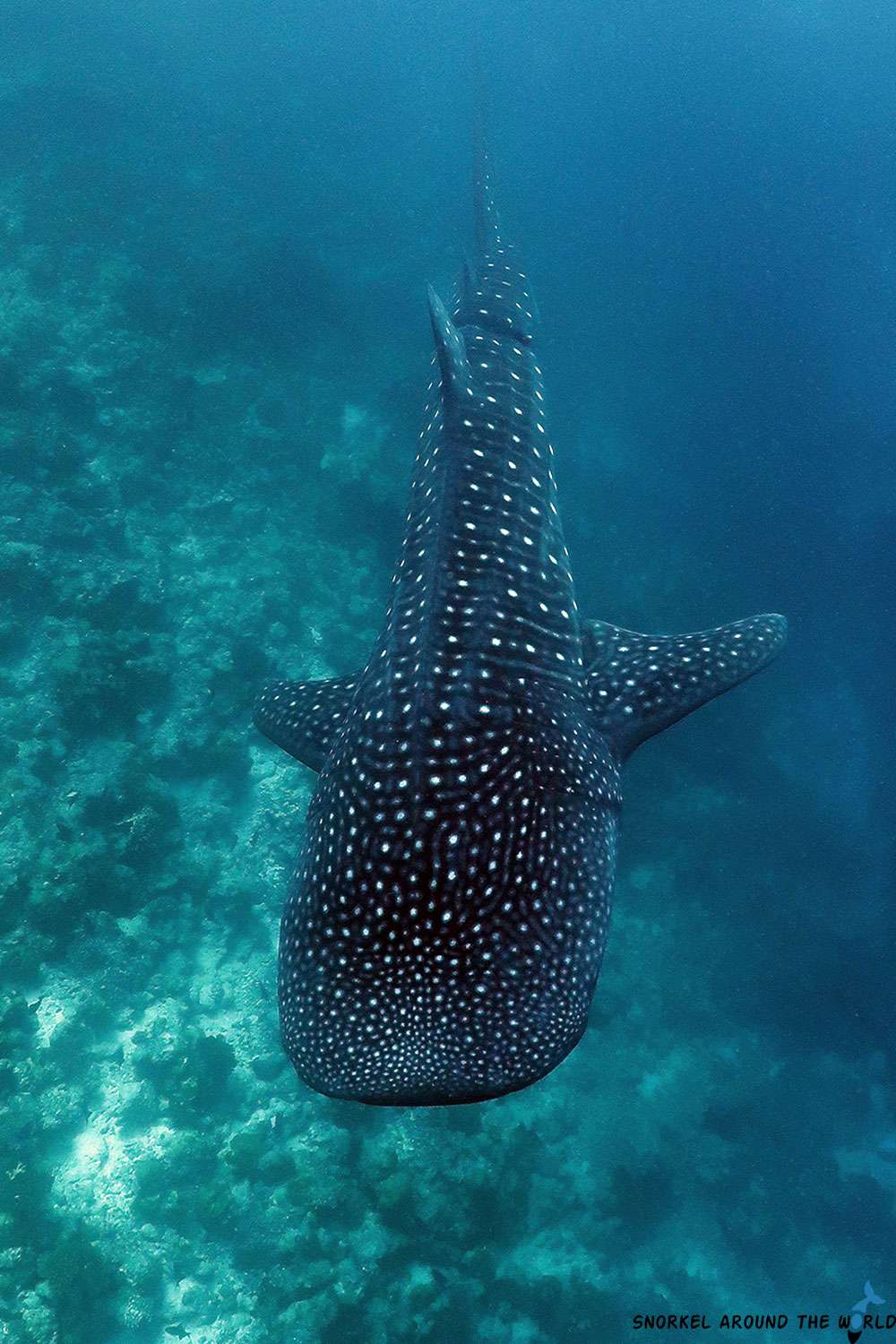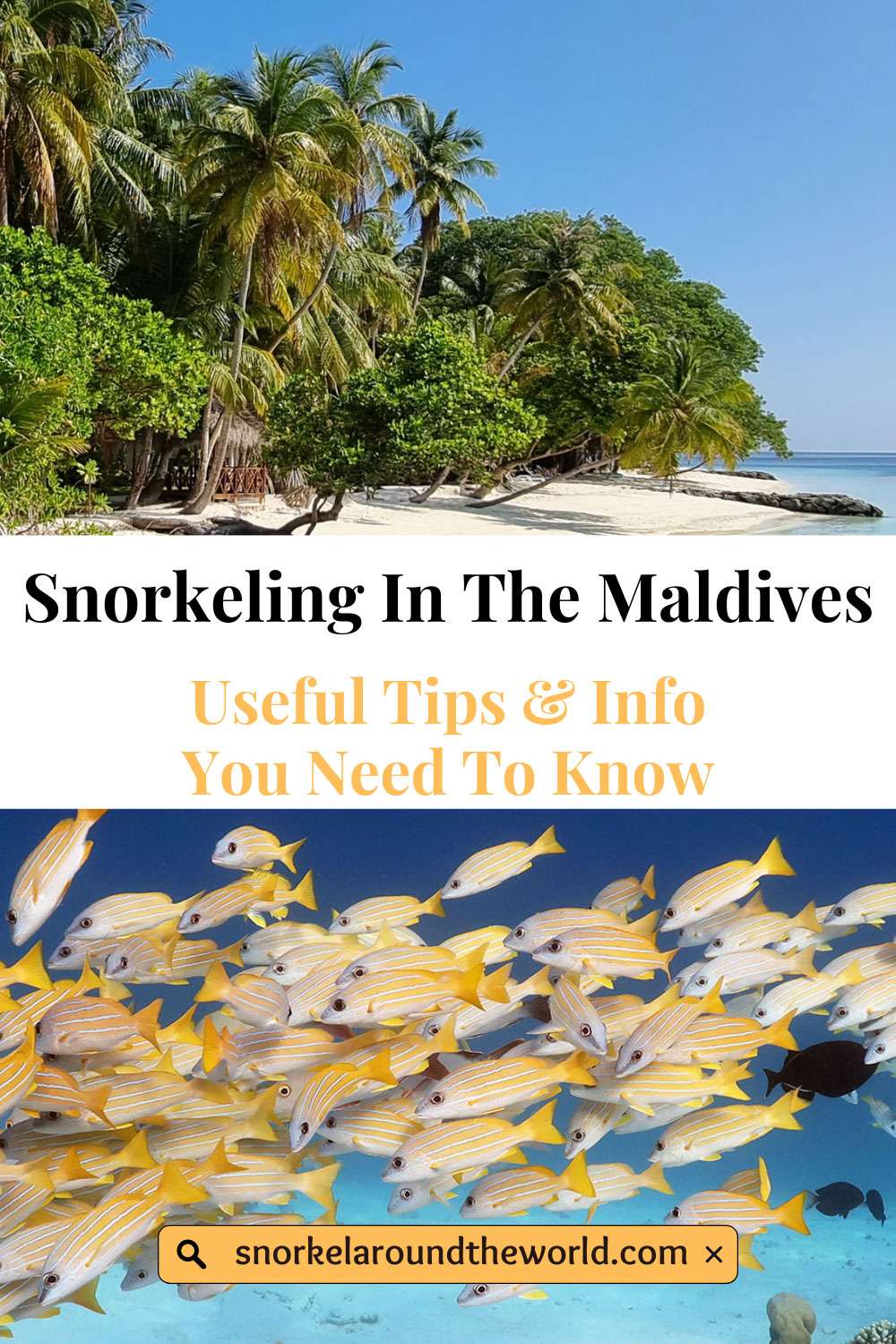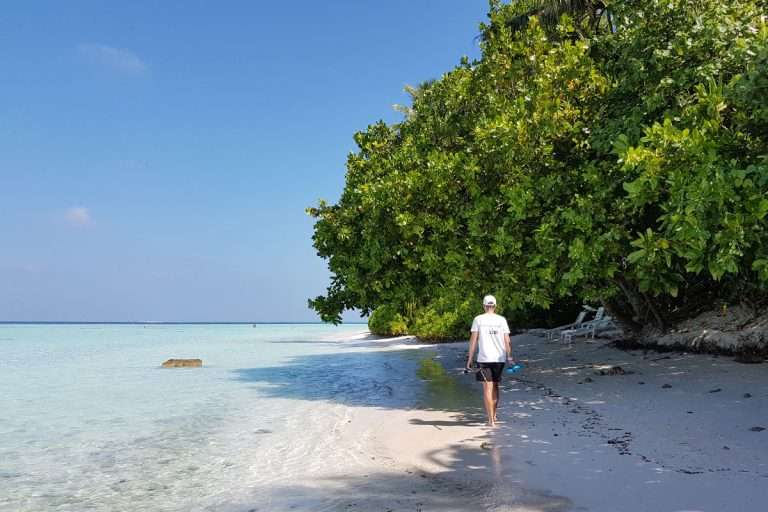Maldives Snorkeling – When/Where to Snorkel, What To See
Constellating along the outline of the equator, the Maldives is famed for offering some of the world’s dreamiest landscapes. We must admit that this island nation is one of our favorite snorkeling destinations, where we return every year. Fine white sand, abundant sunshine, emerald-like waters encircling luxurious resorts, and endless hospitality wait for visitors here. Not only is the scenery that makes this “land constellation” in the Indian Ocean one of the most popular holiday spots, but the underwater world is also first class! Although coral bleaching events caused damage to the reefs, the area still has an incredible marine biodiversity. So why is snorkeling in the Maldives so good? What is the best time to come, and on which island should you stay? Let’s find out together!
Does the Maldives have good snorkeling?
The Maldives is undoubtedly one of the best snorkeling destinations. There are many reasons why these coral islands are a top spot for those who want to explore the ocean’s wonders.
The calm, clear waters create conditions that are generally very safe for all ages and experience levels. Water temperatures averaging a comfortable 82 degrees Fahrenheit (28C) year-round ensure that underwater activities can be comfortably carried out in all seasons.


In addition, shallow lagoons buffering the islands are usually enclosed by reefs that create “gated” spots for rich marine life. The Maldives reefs are home to over 200 coral and 1000 fish species.
With a wide variety of accommodation options from guesthouses on budget local islands and luxurious resort islands, this destination in the Indian Ocean can cater to people seeking the best snorkeling in the world.


With house reefs easily reachable from the shore and fantastic boat-accessible snorkel sites where the ocean’s most beautiful creatures, such as whale sharks and manta rays, can be seen, visiting the Maldives should be on every snorkeler’s and diver’s bucket list.
Where can I snorkel in the Maldives?
There are so many ways to enjoy snorkeling in the Maldives. Launching from one of the many sandy beaches available for tourists is the most common way.


Snorkeling resorts allow direct shoreline access; guests can enter the water easily from the beach using guidance and maps. Sometimes, they even provide gear.
While shore snorkeling is popular here, if it won’t satisfy you and you want to experience some other diving sites too, you can book boat excursions at every island and resort.
What can I see when snorkeling in the Maldives?
Another reason for the fanfare over Maldives snorkeling is the rich biodiversity under the tides, creating great potential for spotting interesting sea life! During snorkeling, you can observe many types of Maldives fish such as parrotfish, clownfish, angelfish, and butterflyfish.
The vibrant orange clownfish and royal-blue tang that are best known from the “Finding Nemo” animated underwater movie are also among the common reef fish to spot here!


The Maldivian archipelago is also home to abundant populations of majestic hawksbill, loggerhead, leatherback, and green sea turtles making it a to-go destination for those dreaming about swimming with sea turtles.


Biodiversity in the Maldives is extraordinary. The region is home to more than 2,000 distinct coral reefs representing more than 258 stony coral reef species. These reefs represent 3.14% of the world’s total reef area!
Due to the risks of coral bleaching caused by pollution and climate change, Maldives visitors need to be conscious of conservation as they interact with the natural environment around them.
What is the best time to go snorkeling in the Maldives?
Snorkeling never shuts down for the season in the Maldives! It is a year-round destination for snorkeling and diving as the water temperature stays comfortable, inviting 82-84 degrees Fahrenheit (27.7-28.8C) throughout the year. However, it’s important to time a visit with full knowledge of the wet season.


The period from January through April is generally considered the best season for snorkeling in the Maldives. Visitors can enjoy sunny days, clear water, and gentle conditions before the monsoon season begins.
The wet season (monsoon season) in the Maldives lasts from May to November. While tourists still come to the islands during this period, be aware that there is a high chance of rain, thunderstorms, and strong winds that could interfere with planned snorkeling excursions.


However, this period is the main whale shark season, so many divers and snorkelers intentionally schedule their holiday between May and November, especially between late June and October which is the peak of the manta ray feeding season too.
During the southwest monsoon, the region’s hotspot is Baa Atoll where you can experience swimming among hundreds of manta rays while snorkeling in Hanifaru Bay.
So, visiting the Maldives in the wet season is not a bad idea; you just need to accept that it might rain.
Which Maldives island is the best for snorkeling?
There’s no shortage of great islands for snorkeling in the Maldives. However, different islands can offer different experiences. You can choose to stay at private resort islands or at local islands (these are inhabited islands where the locals live).
Local islands offer more affordable accommodation and the opportunity to explore the real face of the Maldives but have stricter rules. For example, you can swim in a modern bathing suit (aka bikini) at the designated bikini beaches only and cannot consume alcohol.
Resort islands do not have such rules as they are private. They are considered more organized and cleaner, but consequently, they come with a higher price tag.
One can find excellent options in both categories; here are a few examples that are the most suitable for a snorkeling vacation:
Resort islands
Private resort islands also offer great opportunities to snorkel in style while staying in the Maldives.


Should you look for one that is considered to be affordable, Biyadhoo Island Resorts is at the top of our best Maldives snorkeling resorts list. Located on the North Male Atoll, Biyadhoo has an excellent house reef for divers looking to explore an underwater world.


You will find seagrass beds teeming with feeding turtles, angelfish, octopus, starfish, sharks, and more here! Booking a stay at this lagoon-encased resort gives visitors unlimited access to the entire reef.
Embudu Village is another good option just 20 minutes boat ride from the airport. Although it is not the newest resort island it misses those fancy features that Instagrammers and social media influencers look for when traveling to the Maldives, we highly recommend it for those who want to stay at a friendly resort.


The staff is extremely helpful, the food is yummy, the cocktails are fantastic, and snorkeling at Embudu offers a lot to see; these features make this island an excellent choice for first-time Maldivers and for anyone looking for an affordable resort island.
Vilamendhoo Island Resort is a popular resort among those wishing to swim with whale sharks since it is located in the South Ari Atoll, in the whale shark hot spot. If you are lucky, you may encounter a whale shark while snorkeling at Vilamendhoo’s house reef as sometimes they pass along the island too.


With friendly staff, excellent service, stunning scenery, and vibrant aquatic life, this island offers great value for money.
Universal-owned Kuramathi is another great island offering easy access to snorkeling sites. Located in the Ari Atoll, this resort island routinely attracts vacationers looking for an island with amazing photogenic sandbank easy house reef snorkeling.
Budget local islands
One of the best ways to save money on a Maldives snorkeling holiday is to focus on affordable local islands that offer bed and breakfast-type packages for far less than the “glitzier” islands. Some of them have on-site snorkeling too but all offer boat excursions to the area’s popular snorkeling sites for affordable prices.


Maafushi is widely considered to be the cheapest island in the Maldives because it’s home to dozens of budget hotels. Moreover, travelers can book public ferry rides to and from Male Velana International Airport instead of paying for private speedboat transportation.
Dharavandhoo Island is another budget island that never makes visitors feel like they’re “going cheap.” Located in the middle of UNESCO’s only marine biosphere reserve within the Maldives, Dharavandhoo Island shows off priceless natural beauty that outshines the expensive and flashy resorts found on other islands.


One of the few inhabited islands in the North Ari Atoll, Thoddoo has over 20 budget hotels. While the white-sand beaches here are free to enter, guests can also book a variety of cheaper-than-average snorkeling and island-hopping excursions for bigger adventures.


Ukulhas is another budget island in the Maldives to make the list. A genuine fishing village, Ukulhas is home to several economy hotels and guest houses. This island has its own great house reef and lagoon, so guests never feel like they’re sacrificing to save money by staying here. Moreover, Ukulhas has earned praise for being one of the most ecologically minded islands in the Maldives.
What to pack for a Maldives snorkeling trip?
Preparation is everything when enjoying a safe snorkeling expedition in the Maldives. While many of this island nation’s shallower snorkel spots are appropriate for family adventures, attempting to dive without proper gear and safety measures is extremely dangerous.
Properly fitted masks, snorkels, and fins are needed for safe snorkeling. If you are not fully comfortable swimming in open water yet, bring a float vest.
A mask defogger also comes in handy, as masks tend to fog more easily in warm waters. My pro tip is to pack some neoprene socks, which will help prevent blisters on your feet caused by friction from fins.
When visiting remote Maldives islands accessible only by seaplane, packing can be an issue, as strict baggage weight restrictions exist. Luckily, renting snorkeling equipment in the Maldives is as easy as ordering a cup of coffee.
Underwater tourism is one of the biggest industries in the Maldives, so resorts often allow guests to rent snorkel gear without ever leaving their rooms. Snorkel gear is also provided when booking a snorkeling excursion with a local guide.
Do I need a wetsuit to snorkel in the Maldives?
Not necessarily. Technically, only a comfortable, secure-fitting swimsuit is needed as the water is warm enough year-round (80-86F/27-30c) to go snorkeling in the Maldives. Only those who are sensitive to cold water should bring a shorty so they won’t start feeling cold even when spending hours in the water.
On the contrary, even if a wetsuit is unnecessary, we highly recommend wearing full-body UV protection clothing whenever you go snorkeling to avoid sunburn.
How much does snorkeling cost in the Maldives?
The biggest advantage of staying on Maldives islands with a good house reef is that you can snorkel from the shore for free. Those who need guidance can sign up for guided house reef snorkeling for approx. $25-50 per person.


Boating excursions tend to cost more. Expect to pay between $50 and $250 to be transported to snorkeling sites by boat. Generally, special snorkeling tours such as whale shark, dolphin, or manta ray trips are more expensive than a general reef snorkeling tour.
Author’s Tip: Guests booking all-inclusive packages at certain resort islands often enjoy complimentary snorkel excursions. Check this with the resort of your choice before making a reservation!
Is snorkeling safe in the Maldives?
The Maldives offers some of the safest snorkeling conditions in the world. In fact, shallow sites that are buffered by lagoons offering safe snorkeling for first timers and for kids too. For novice snorkelers, the best way to stay safe is to snorkel with a guided group instead of trying to determine which sites are safe on your own.


It’s generally recommended that non-swimmers avoid snorkeling, however, they can view marine life in lagoons where the water is shallow enough to stand. Also, the ocean in the Maldives is so crystal clear that you can spot some creatures without snorkeling simply by standing near the water!


Are there dangerous marine animals in the Maldives?
The truth is that danger lurks any time humans enter the natural habitats of wild creatures. The ocean environment surrounding the Maldives is no different, but marine life will generally leave humans completely undisturbed if snorkelers and divers keep a respectful distance.


Certain fish species (such as Lionfish, Titan Triggerfish, Barracudas, Surgeonfish), moray eels, and sea urchins are generally considered the most dangerous forms of marine life in the Maldives. These creatures won’t hesitate to use spikes, venom, or bite if they feel attacked.
However, aggressive encounters are extremely rare. Snorkelers should keep a distance of at least 8 feet (2.5m) from all sea life to ensure safe, relaxing adventures.
Do snorkelers in the Maldives have to worry about sharks?
Reef sharks are commonly spotted during snorkeling excursions. The black-tip reef shark is common in reefs and lagoons due to its preference for shallow water. While this shark is typically not aggressive, caution should be exercised when one is spotted.


White-tip reef sharks are known to be slightly more curious when investigating human activity. Still, snorkelers can enjoy the peace of mind of knowing that shark attacks in the Maldives are essentially non-existent.


The Maldives’ most famous shark, which every snorkeler and diver wants to encounter at least once in their lifetime, is the giant whale shark. This shark can be spotted in the area year-round, with a peak season in September/October. Despite their size (whale sharks can grow up to 39ft/12m long), these creatures are generally harmless to humans as they are filter feeders.
What to watch out for when snorkeling in the Maldives?
To make your Maldives snorkeling holiday safe and smooth, keep in mind the following:
Do not touch corals
One of the most important rules of snorkeling safety is to avoid touching any marine life or corals with your hands. Not touching the corals is highly important because the Maldives’ reefs are in a recovery phase after the devastating bleaching events that affected about 70% of them, so while snorkeling, you will see both live and dead corals. Any contact with the corals might worsen their condition and prevent them from recovering.
On the other hand, touching corals can cause allergic reactions and/or injuries. Many people assume that corals don’t pose threats because they are “passive.” In reality, the soft living material of a coral hides an abrasive structure that can easily tear at skin with the slightest touch or bump.
Coral penetrating the skin can lead to a wound with a dangerous bacterial infection. In addition to keeping humans safe from stings, bites, and attacks, the no-touching rule also ensures that humans don’t inadvertently upset the balance of the underwater ecosystem.
Think about sun protection
While many people assume that they are protected from the sun while under the water, the reality is that the chances of getting sunburn are even higher while snorkeling because the water reflects the sun’s harmful UV rays.


Moreover, time spent on a boat or beach while preparing to snorkel is spent in the sun. Never visit the Maldives without clothing that protects the region’s high UV index (rash guard). A biodegradable, reef-friendly sunscreen is also essential for those areas of the face and body that aren’t covered by your wetsuit or protective clothing.
Pay attention to weather and water conditions
While it’s easy to focus on dramatic attacks from creatures of the deep, the truth is that the biggest risk humans face is pretty simple. Bad weather and rough seas can pose a big threat to humans.
Strong currents can be present in some areas in the Maldives; sudden surges can pull snorkelers down into the water. A rip current can leave a snorkeler completely disoriented. Violent surges can also drop snorkelers down against hard rocks and reefs.
This is why beginner snorkelers should only explore the water as part of a guided group, and experienced ones should take weather warnings seriously. Resorts’ professional snorkeling instructors are trained to spot dangerous weather patterns and water conditions so they can provide guidance to snorkelers and deliver emergency support if needed. When staying on an inhabited island, ask locals where and where it is safe to snorkel if you have concerns.
Inspired? Pin it!







